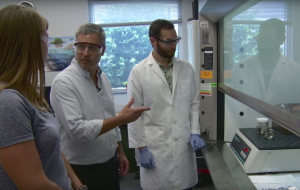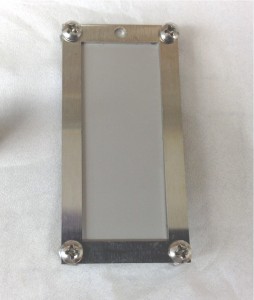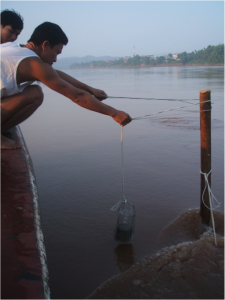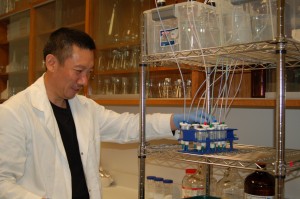Commercializing passive sampling technology to enhance the risk analysis process
Dr. Damian Shea and his team at North Carolina State University have developed a new passive sampling technology that provides more accurate estimates of chronic exposure to hundreds of bioavailable chemicals in water, as part of the UNC Superfund Research Program’s Project 4. In addition, a new start-up company, Statera, LLC, has been created by Dr. Shea to manufacture, market and distribute this new technology to users in the United States and across the globe.

Dr. Damian Shea (middle) discusses analysis of a PSD sample with his team of researchers.
The technology, called a non-selective passive sampling device (ns-PSD), enables risk assessors involved with Superfund and other hazardous waste sites to gain critical information related to bioavailability, or the ability of a chemical to be taken up into animals and the human body, as well as time-weighted averages of contaminant concentrations in surface waters. Risk assessors can then better understand and predict exposure rates and develop more accurate human health risk assessments.
The traditional means of gathering such data — by collecting a time series of grab samples and then analyzing each sample – can be prohibitively expensive and does not necessarily capture fluctuations in contaminant concentrations as they ebb and flow over days or weeks. It also does not enable regulators to take into account how much of a contaminant is bioavailable.
Passive sampling devices currently on the market measure organic chemicals in water and fall into two general categories: those used to measure hydrophobic chemicals, like polychlorinated biphenyls (PCBs) and polycyclic aromatic hydrocarbons (PAHs), and those designed for use with water-soluble or hydrophilic chemicals. To complicate matters, many chemicals fall in the intermediate range of moderately hydrophilic-moderately hydrophobic and do not work well with either PSD.
Enhanced capacity for sampling a wide range of chemicals

The ns-PSD, pictured here, can sample a wide range of chemicals in surface water to provide an accurate estimate of exposure over time.
The ns-PSD has been calibrated in the laboratory for over 400 chemicals and has been used to measure chronic exposure to over 250 chemicals at various field sites around the world, including: PCBs, dioxins and furans, PAHs and PAH metabolites, current-use pesticides and metabolites (both polar and non-polar), chlorinated pesticides, natural and synthetic estrogens and androgens, antibiotics, microcystin-LR, and a suite of pharmaceuticals and personal care products.

Colleagues of Dr. Shea deploying the ns-PSD on the Red River in northern Vietnam.
A new venture
To facilitate manufacture, marketing and distribution of this new ns-PSD technology, Dr. Shea has created a new start-up company called Statera, LLC. The name is derived from the Latin word meaning “balance,” as the company hopes to develop products and services that help society strike a balance between using natural resources and protecting the environment. Dr. Shea is initially serving as CEO and Dr. Xin-Rui Xia, a researcher in Shea’s lab at NC State University, leads development and manufacturing with assistance from Xiang Kong. Dr. Xia and Ms. Kong have been essential in the development of the PSDs and are key contributors to Project 4 within the UNC SRP Program.
Statera is initially focusing on the commercialization and practical application of the ns-PSD for use in chemical exposure assessment, an essential step in creating human and ecological risk assessments and setting remediation goals at EPA Superfund Sites and other areas potentially impacted by chemicals.
The first order for 1,000 of Statera’s PSDs has been placed by the Kunming Chao Tai Trade Co., Ltd., who will serve as the importer and distributer for these PSDs in China. The ultimate end user of this order will be researchers at Yunnan University in Kunming, China who will use the ns-PSDs to monitor chemical exposure in major rivers used for drinking, bathing, washing of food, and agricultural irrigation in Yunnan Province, China. Data gathered through the ns-PSDs will be used to analyze health risks to humans and ecosystems.
From research to real world

Dr. Xin-Rui Xia is currently leading development and manufacture of the ns-PSD’s for Statera.
Dr. Shea developed the initial concept for the ns-PSD, which has been refined over the years by graduate students, staff, and post-docs. “Major advances came the past few years under funding from the NIEHS through the Superfund Research Program,” remarked Shea. “This funding was critical in allowing us time to develop the theory, work through many different chemical synthesis and engineering issues, and perform the extensive laboratory and field studies needed to validate the PSDs and prove their efficacy and utility.”
The bulk of the design advances were made by Dr. Xin-Rui Xia in Shea’s laboratory at NCSU with assistance on the calibrations and field verifications from SRP trainees Kelly O’Neal, Sandy Mort, and Andrew McEachran along with NIEHS-supported staff Peter Lazaro and Anna Kong. Additional financial support in China allowed Shea’s team to demonstrate their value in helping the Chinese government and university researchers evaluate chemical exposure in surface waters in China.
